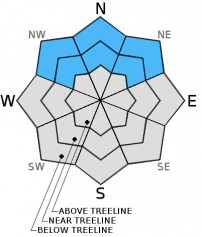| Monday | Monday Night | Tuesday | |
|---|---|---|---|
| Weather: | Partly cloudy becoming mostly cloudy during the day | Mostly cloudy | Mostly cloudy |
| Temperatures: | 42 to 50 deg. F. | 22 to 32 deg. F. | 36 to 46 deg. F. |
| Mid Slope Winds: | Variable | Southwest | Southwest |
| Wind Speed: | Light | 10 to 15 mph with gusts to 25 mph | 15 to 20 mph with gusts to 30 mph |
| Expected snowfall: | 0 | 0 | 0 |
| Monday | Monday Night | Tuesday | |
|---|---|---|---|
| Weather: | Partly cloudy becoming mostly cloudy during the day | Mostly cloudy | Mostly cloudy |
| Temperatures: | 35 to 45 deg. F. | 20 to 30 deg. F. | 30 to 40 deg. F. |
| Ridge Top Winds: | Southwest | Southwest | Southwest |
| Wind Speed: | 5 to 15 mph with gusts to 25 mph in the afternoon | 20 to 30 mph with gusts to 50 mph | 15 to 25 mph with gusts to 45 mph |
| Expected snowfall: | 0 | 0 | 0 |

























